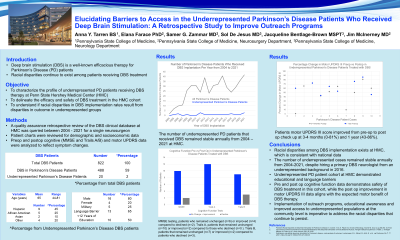Elucidating Barriers to Access in the Underrepresented Parkinson’s Disease Patients Who Received Deep Brain Stimulation: A Retrospective Study to Improve Outreach Programs
Friday, April 21, 2023


Anna Tarren (she/her/hers)
Medical Student
Pennsylvania State University College of Medicine
Hummelstown, Pennsylvania, United States
ePoster Presenter(s)
Introduction: Deep brain stimulation (DBS) is a widely known efficacious therapy for Parkinson’s Disease (PD), however, studies have shown persistent disparities. The purpose of this study is to investigate the characteristics and elucidate the outcomes of underrepresented populations of PD patients treated with DBS in a tertiary academic medical center in Central Pennsylvania.
Methods: A quality assurance retrospective review of the DBS clinical database at HMC was queried between 2004-2022. Demographics, potential barriers to access PD-DBS treatment (i.e. educational level, language barrier, military status) and clinical information were obtained for underrepresented groups. Response to DBS treatment were based on objective measurements by neuropsychologist's, physician’s, and physical therapist’s evaluations prior to the procedure and during their 3-12-month follow-up appointments.
Results: A total of 488 patients out of 822 had received DBS for PD. Twenty-two PD patients (2.7% of all DBS patients / 4.5% of all PD patients) were identified as belonging to an underrepresented group: Hispanic (n=11), African American (n=5), Asian (n=2), and other (n=4). Within this underrepresented cohort, there were 15 patients who had a language barrier requiring an interpreter, 10 patients with 12 years or less of education, and 5 patients with a military history. The number of underrepresented cases per year remained stable between 2004-2022.
Conclusion : The PD-DBS cohort in our institution is reflective of national trends. Preliminary data suggest underrepresented groups have numerous barriers to their medical care for DBS therapy; however, our data suggests these patients continue to have positive outcomes with DBS therapy. Additionally, the number of underrepresented cases remained stable annually, despite the number of years the therapy has been available and anticipated increased awareness with competition/innovation in neuromodulation. Our findings highlight the need to better understand barriers, referral patterns, and community engagement needs, to effectively improve access to advanced therapy in underrepresented populations.
Methods: A quality assurance retrospective review of the DBS clinical database at HMC was queried between 2004-2022. Demographics, potential barriers to access PD-DBS treatment (i.e. educational level, language barrier, military status) and clinical information were obtained for underrepresented groups. Response to DBS treatment were based on objective measurements by neuropsychologist's, physician’s, and physical therapist’s evaluations prior to the procedure and during their 3-12-month follow-up appointments.
Results: A total of 488 patients out of 822 had received DBS for PD. Twenty-two PD patients (2.7% of all DBS patients / 4.5% of all PD patients) were identified as belonging to an underrepresented group: Hispanic (n=11), African American (n=5), Asian (n=2), and other (n=4). Within this underrepresented cohort, there were 15 patients who had a language barrier requiring an interpreter, 10 patients with 12 years or less of education, and 5 patients with a military history. The number of underrepresented cases per year remained stable between 2004-2022.
Conclusion : The PD-DBS cohort in our institution is reflective of national trends. Preliminary data suggest underrepresented groups have numerous barriers to their medical care for DBS therapy; however, our data suggests these patients continue to have positive outcomes with DBS therapy. Additionally, the number of underrepresented cases remained stable annually, despite the number of years the therapy has been available and anticipated increased awareness with competition/innovation in neuromodulation. Our findings highlight the need to better understand barriers, referral patterns, and community engagement needs, to effectively improve access to advanced therapy in underrepresented populations.
